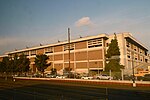Patsaouras Transit Plaza
Bus stations in Los Angeles County, CaliforniaLos Angeles County Metropolitan Transportation AuthorityLos Angeles Metro Busway stationsPages with no open date in Infobox station

Patsaouras Transit Plaza is a bus station on the east side of Union Station in Downtown Los Angeles, near the El Monte Busway. It was originally named the Gateway Transit Plaza but was renamed after Nick Patsaouras, former Rapid Transit District board member who was an advocate for public transportation. The Metro Headquarters Building is located at the northern end of the plaza.
Excerpt from the Wikipedia article Patsaouras Transit Plaza (License: CC BY-SA 3.0, Authors, Images).Patsaouras Transit Plaza
North Vignes Street, Los Angeles Downtown
Geographical coordinates (GPS) Address Nearby Places Show on map
Geographical coordinates (GPS)
| Latitude | Longitude |
|---|---|
| N 34.055277777778 ° | E -118.23305555556 ° |
Address
Union Station East Parking Garage
North Vignes Street
90086 Los Angeles, Downtown
California, United States
Open on Google Maps











